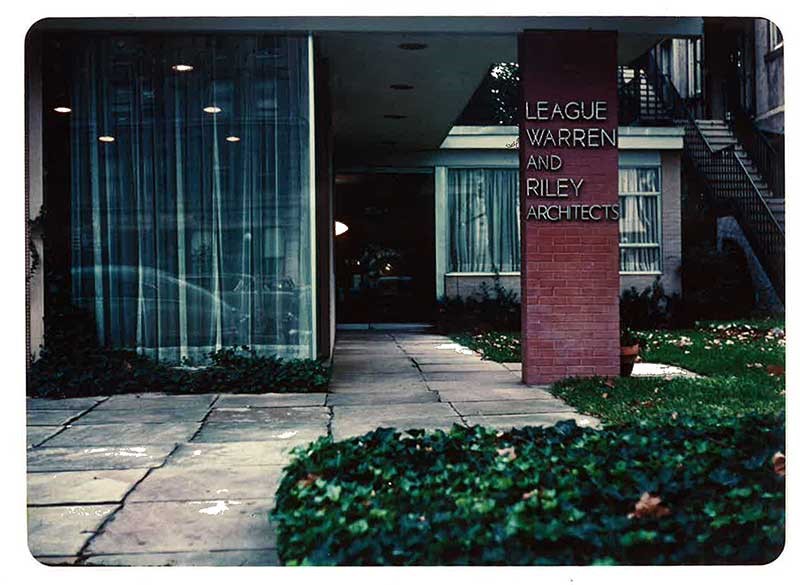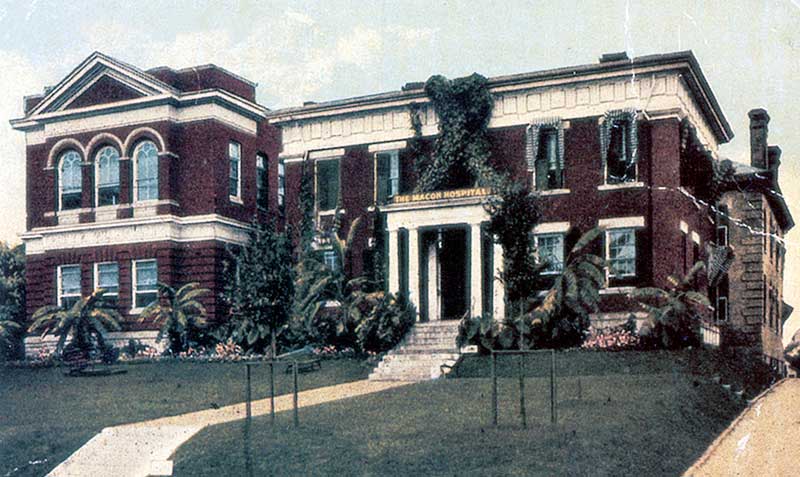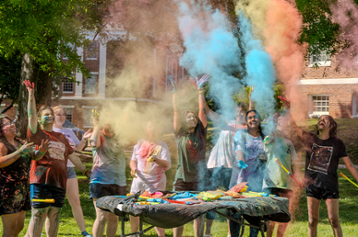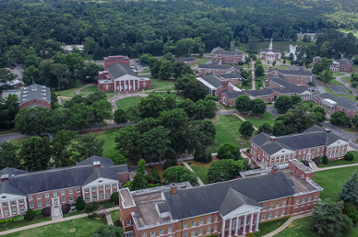I was always an architect. Not a 'woman architect,' but an architect.
- Ellamae Ellis League ’20
This article was featured in WESmag Fall 2013 issue
by Cynthia McMullen ’76
Macon native and Wesleyan College alumna Ellamae Ellis League ’20 certainly was not an overt maverick. As one of the country’s first women architects, it wasn’t her plan to stir things up. She simply wanted to get the job done.
So she did just that. In her 50-plus-year career as an architect, League designed original buildings and renovation plans for dozens of structures in the Macon area, many of which still stand. Her passion and talent also accrued a plethora of awards in her chosen profession.
Her son, 92-year-old Joseph Choate League of Macon, attributes his mother’s success to the fact that she always was a lady. His late sister, he recalls, said, “She first was a lady and then a good businessman.” Their mother would have appreciated the humor in that statement.
Born in 1899, Ellamae Ellis grew up on Magnolia Street. Perhaps that accounts for her love of the area, where she lived and worked throughout her life. In later years, explaining why downtown Macon should capitalize on its old charm, she said, “I love downtown. I wouldn’t get caught dead at the mall!”
Young Ellamae studied in Macon public schools and went on to attend Wesleyan College in 1916. She was married the next summer. Five years later, Ellamae League began her life in earnest: rearing two young children on her own.
Even though she was a woman, a rarity in the field, architecture made sense for League. She had talent, ambition… and a highly impressive architectural ancestry.
According to family history, six generations of architects, all men, had preceded League. She credited her architect uncle, Charles Edward Choate of Atlanta, for putting the idea in her head. But she knew it wouldn’t be easy.
League did the next best thing, applying in 1922 as an apprentice to the architectural firm of Dunwody and Oliphant. “Soon,” a Macon News reporter wrote somewhat breathlessly, “the mother-turned-architect was doing a man’s share in the office.”
League and her children might have disagreed with the phrase, “mother-turned-architect.” She was an architect, true, but still very much a mother. League also might have taken issue with the phrase, “man’s share.” As far as she was concerned, she was doing her job. Gender wasn’t part of it.
Local media were fascinated by League. In 1933, a reporter asked if she took work home with her. League replied that while the work was strenuous and could be nerve-racking, she enjoyed spending evenings with her progeny. Besides, she noted, “My children are in high school, and I have to try and remember the Latin and French I used to know so I can help them. It really is harder for me than the work at the office.”
The reporter, apparently coveting a more exciting home life for League, ended the interview: “She doesn’t even play bridge.”
According to son Joe, his mother wasn’t short of suitors. A few even had asked his permission to marry her. “But she wasn’t interested.”
She probably didn’t have time. While working full-time and raising Joe and Jean, she also took architecture correspondence courses from the Beaux-Arts Institute of Design in New York. Around 1928, she took some time to study at the Ecole des Beaux-Arts in Fontainebleu, France. (Her parents took care of the children while League was abroad.)
Everything changed in 1933 when William Oliphant died. League took charge of the office, applied to be a registered architect and, in 1934, opened her own firm. One observer noted that for the previous decade League had helped prepare plans for every school built in the community.
The Macon newspaper reported that at the time, “so far as is known here,” League was the only female registered architect in the state of Georgia. It is perhaps telling that her Architectural Association certificate arrived addressed to “Mr. Ellamae Ellis League.” In 1934, just two percent of American architects were women.
League was credited with having given many young architects their start, and her firm had no trouble staying busy. In 1938, a news story titled “Macon’s Architects Hold Fat Contracts” cited League’s as one of four firms handling more than $2 million in work ranging from homes to schools and municipal and university buildings. In 1939, hers was one of three firms designated by the Macon Housing Authority to draft plans for low-cost federal aid housing projects.
In 1940, League designed her own house at 1790 Waverland Drive in Shirley Hills, where she lived until her death in 1991. In a 1981 interview, she said, “I had an aversion to using the local red brick used by most Macon homebuilders. … I decided to use California redwood siding and red roof shingles for a more mellow color, and also for permanence provided by no other wood.”
The unusual building material evoked a cabinesque feel. Now known as the Ellamae Ellis League house, it is owned by Dennis McCleary, music director for Vineville United Methodist Church. In 2005, it was recognized by the National Register of Historic Places.
League’s design portfolio was nothing if not varied: schools (Winship School, Ballard-Hudson Area Vocational Technical School), public housing (Pendleton Homes, Oglethorpe Homes and Tindall Heights), hospitals, commercial buildings (Scottish Rite Temple), parking garages, a service station, even a residential bomb shelter. Later in life, she would note a particular interest in church architecture. A member of Mulberry Street United Methodist Church, she designed its new sanctuary after a 1965 fire. She also assisted with plans for Vineville and Cherokee Heights Methodist churches.
Although she felt commercial architecture was more viable, League admitted “residences are a lot of fun, especially when you have a good client who cooperates and takes your advice.” Early in her career, she made the comment that women should be better residence designers; they know more about “convenient and harmonious arrangement.”
Looking back, she said, every building she had worked on was a favorite.
Following in her mother’s footsteps, Jean League decided to pursue architecture. After earning degrees at Radcliffe and Harvard, she joined her mother’s firm. Perhaps surprisingly, she said her mother did not approve of her choice of profession. “But when I completed my studies at Harvard in 1945, she welcomed me with open arms because all of the man architects with whom she was associated were in the armed forces!”
Jean League Newton practiced architecture until she retired in 1990. In a 1945 interview, the mother-daughter team discussed their different approaches. Ellamae aligned herself with the Ecole des Beaux-Arts style, which was modeled on classical antiquities. Jean was a product of the modern school, leaning toward simpler forms. Both agreed that individuality is important and that American architecture should not be limited by time or tradition.

League, Warren, and Riley Architects downtown Macon office building
Described variously as “slender,” “blue-eyed,” “petite” and with “intense features,” League also had a sense of humor. Asked what it was like to be her daughter’s boss, she replied, “It’s wonderful. I can send her grocery shopping during office hours.”
In the late 1940s, League developed an association with fellow Macon architects Delmar Warren and Oliver M. Riley. They designed a downtown building to house their offices. In 1950, League and Newton prepared plans for another California redwood house in Shirley Hills, this time at 1849 Waverland Drive. A ranch house meant to look quiet, comfortable and simple, the design was cutting-edge.
Joe League, who lived there until recently, enjoyed the fact that it never needed paint. “It just weathers,” he said. His house joined his mother’s on the National Register of Historic Places in 2009, the first mid-20th century ranch house in the state to be so designated.

The original Medical Center in downtown Macon
In 1953, League’s group was hired to help design Macon’s new 500-bed hospital, a $6 million project divided among four architectural firms. Even years later, she couldn’t escape the “little woman” syndrome. A newspaper story out of Atlanta trumpeted, “A glamorous grandmother architect is playing an important role in plans for construction …”
Despite her own success, League knew the odds for women in the field. She described architecture for women as a “back-breaking job.” In fact, when the president of Georgia Tech approached her about plans for an architecture course for coeds, she replied, “I’m all in favor of women having the right to study architecture. But I wouldn’t advise any woman to accept it as a career.”
A member of the American Institute of Architects since 1944, the “glamorous grandmother” continued to make inroads for women in the profession. In 1957, she established the Macon Chapter of the American Institute of Architects and served as its first president. In 1963, she served as the first president of the Georgia Council of Architects, predecessor of the Georgia Association. In 1968, she was elected a fellow of the AIA, an honor accorded very few women.
League also was selected by the North Georgia Chapter of the AIA to receive the Ivan Allen Senior Trophy for her efforts in civic improvement. In presenting the award, Ivan Allen III said, “Mrs. League recognized the historic value of the Grand Opera House building and called in her own engineers, in addition to making her own survey of the condition of the building, in order to convince Macon people that it should be saved.”
The same year the Grand Opera House renovations were completed, League received one of Wesleyan College’s three 1969 Alumnae Awards for Distinguished Achievement. A feature in the Macon newspaper included a photo of all the recipients, but the story covered only one of the three award winners: the actress Eugenia Rawls. Rawls was thrilled about the Grand’s restoration, as she had watched her first play and made her acting debut there.
Apparently neither Rawls nor the newspaper writer knew that day that Ellamae Ellis League – Rawls’ fellow Distinguished Alumna recipient – had been responsible, in great part, for saving the Grand.
League was as big a cheerleader for Macon as anyone around. As her business grew, so did her involvement with the community. She served as president of the Business and Professional Women’s Club and worked with the Georgia Department of Mental Health Citizens Council and the Bibb County Board of Health. She was on the Macon Little Theatre’s board of directors for 40 years, occasionally lending her skills to set design.
Still a fan of the downtown area, League enjoyed designing Dunlap and Dempsey parks on Third Street in 1974. More than $100,000 went toward new trees, shrubs, benches and a brick pavilion. “Other cities would give a million dollars to have our parks, and we already had them and weren’t using them,” she commented. “That’s what helps bring people downtown.”
Another of League’s landscaping jobs was a bit closer to home: She designed the plantings in front of Wesleyan’s Candler Alumnae Center and, behind the building, the red brick walk through Fickling Cherry Grove.
In 1975, the year she retired, League became the first Macon architect to receive the AIA-Georgia Association’s Bronze Medal for service to the profession. Seven years later, the Georgia Association bestowed upon League its first-ever Bernard B. Rothschild Award in recognition of most distinguished service to the profession of architecture.
Asked by the Macon News if she had found it difficult getting established as a woman in a small Southern town, League seemed to have grown tired of the question. A supporter of equal rights, she replied, “I’m so sick of women’s lib. Women shouldn’t set themselves apart. If you can do the work, you’ll be accepted. If not, you won’t.”
In 1982, discussing the Rothschild award, League echoed her earlier words, adding, “I encourage women going into the profession not to concentrate on being separate as a woman but to concentrate on being a good architect.”
Despite her protestations, League proved to be a true pioneer for women in architecture – not only in the South but nationwide.
Many of her drawings, architectural renderings and other papers may be found in the Genealogy and Historical Room at Macon’s Washington Memorial Library. Or… you can just look around. As one reporter summed it up more than 30 years ago, “Ellamae Ellis League is responsible for much of the beauty around Macon.”

Wesleyan College is privileged to steward many arts and cultural events and share them with the community. Most are free and open to the public. Wesleyan art galleries are open M-F 1-5PM and on Wesleyan Market Saturdays from 10AM-2PM.
Event listing
Wesleyan competes in intercollegiate athletics with teams in soccer, softball, basketball, hockey, beach volleyball, indoor volleyball and flag football.
View More
Tour our beautiful 200-acre campus featuring Georgian architecture, lush green spaces, recreational facilities, residence halls, and worship center.
Vist Wesleyan Virtually